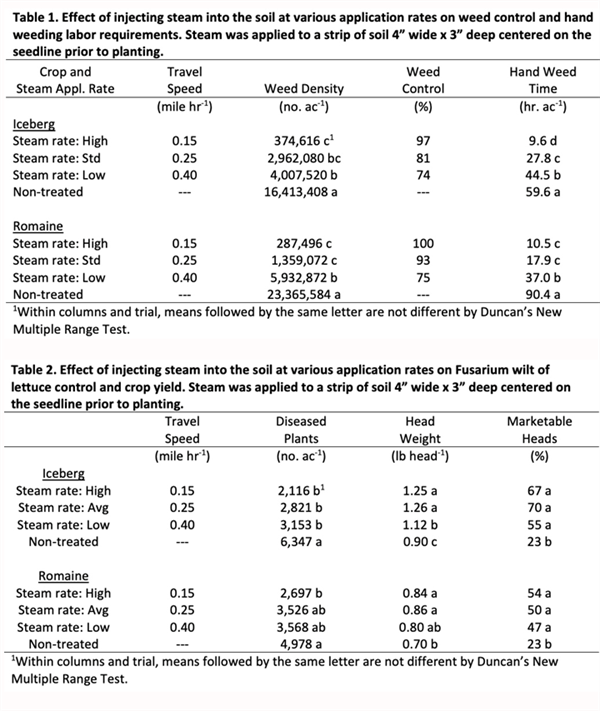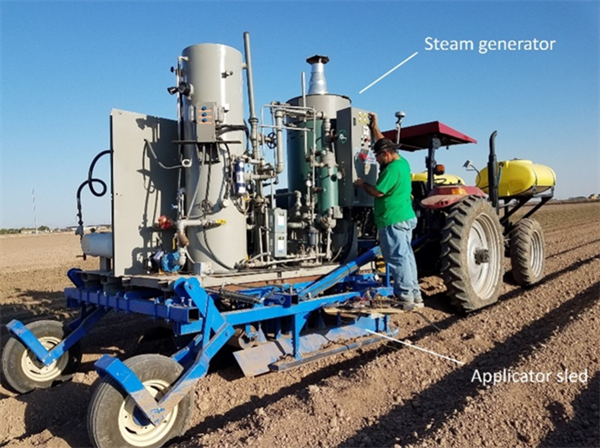Last fall, we established trials investigating the use of band-steam to control weeds and Fusarium wilt of lettuce in iceberg and romaine lettuce. Band-steam is where, prior to planting, steam is injected in narrow bands, centered on the seedline to raise soil temperatures to levels sufficient to kill weed seed and soilborne pathogens (>140 °F for > 20 minutes). After the soil cools (<1 day), the crop is planted into the strips of disinfested soil.
In the study, we utilized the prototype band-steam applicator (Fig. 1) described in a previous UA Veg IPM articles (Vol. 11 (13) to inject steam into the soil as beds are shaped. The steam applicator was configured to treat a 4” wide by 3” deep band of soil. Three rates of steam (Low, Standard, High) were applied by varying travel speed. The “Standard” rate was where steam was applied at rates needed to reach the target soil temperatures (>140 °F for > 20 minutes). Higher and lower applications rate were examined to ensure target temperatures were met/exceeded to get a better understanding of the efficacy of steam treatment, and to determine if higher travel speeds (less fuel consumption) could be used and still provide effective pest control.
Results showed that application of steam was highly effective at controlling weeds (nettleleaf goosefoot predominant species). At the Standard application rate, over 80% of the weeds were controlled. At High application rates, weed control approached 100%. What was particularly encouraging was that at the Low steam application rate where travel speeds were 60% faster than Standard, and target temperatures were not met, weed control was still very good – about 75%.
Steam treatment was also effective at controlling Fusarium wilt of lettuce. Disease incidence in iceberg and romaine lettuce were reduced by more than 50% as compared to the untreated control (Table 2). Crop plants were noticeably larger and more vigorous throughout the growing season in all steam treated plots (Fig. 2). At the Standard and High application rates of steam, this translated into significant yield increases in iceberg (>300%) and romaine (>90%) lettuce. Significant yield increases were also found at the Low application rate of steam – iceberg (>200%) and romaine (>60%).
The results are very promising, but it is important to note that steam treatment is not an end-all cure for Fusarium wilt disease. At the trial site, disease inoculum levels were considered moderate. However, when inoculum levels are very high, our trials have shown that a 4” wide by 3” band of soil is not effective at controlling the disease. We hypothesize that a wider and/or deeper band of treated soil is needed for effective control. This fall, we will be initiating trials to examine this. We will also be investigating the use of band steam to control pythium and nematodes in carrot. Trial results will be presented in future articles - so Stay Tuned.
As always, if you are interested in seeing the machine operate or would like to test the machine on your farm, please feel free to contact me.
Acknowledgements
This work is supported by the Arizona Specialty Crop Block Grant Program and the Arizona Iceberg Lettuce Research Council. We greatly appreciate their support. Any opinions, findings, conclusions, or recommendations expressed in this publication are those of the author(s) and do not necessarily reflect the view of the U.S. Department of Agriculture.


Fig. 1. Band-steam applicator principally comprising a 35 BHP steam generator mounted on a bed-shaper applicator sled.

Fig. 2. Iceberg lettuce planted in beds treated with steam (left) prior to planting and untreated (right).





